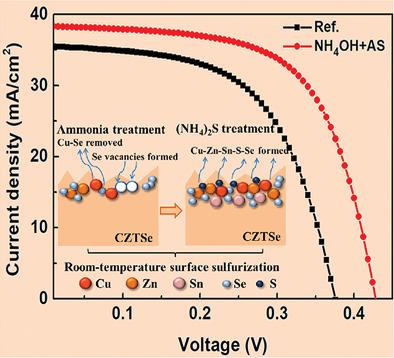当前位置:
X-MOL 学术
›
Adv. Mater. Interfaces
›
论文详情
Our official English website, www.x-mol.net, welcomes your
feedback! (Note: you will need to create a separate account there.)
Nanoscale Surface Electrical Properties Tailored by Room‐Temperature Sulfurization for High‐Efficient CZTSe Solar Cells
Advanced Materials Interfaces ( IF 4.3 ) Pub Date : 2020-06-22 , DOI: 10.1002/admi.202000564 Siyu Wang 1 , Zhan Shen 1 , Jianyu Wu 1 , Li Wu 2 , Hui Li 3 , Guangxing Liang 4 , Jianping Ao 1 , Hai Wang 5 , Yi Zhang 1
Advanced Materials Interfaces ( IF 4.3 ) Pub Date : 2020-06-22 , DOI: 10.1002/admi.202000564 Siyu Wang 1 , Zhan Shen 1 , Jianyu Wu 1 , Li Wu 2 , Hui Li 3 , Guangxing Liang 4 , Jianping Ao 1 , Hai Wang 5 , Yi Zhang 1
Affiliation

|
Surface sulfurization can tailor the energy band alignment between p–n heterojunction for the kesterite‐structured Cu2ZnSnSe4 (CZTSe) solar cells. However, the traditional high‐temperature sulfurization process result in the decomposition of kesterite film and thus introducing deep defects. Room‐temperature surface sulfurization, which do not introduce new deep defects during the sulfurization process, is a good method for sulfurization. Combined by different experimental techniques, in this study, it is found that CZTSe film etched by concentrated ammonia can not only tailor the surface nanoscale composition, but also make CZTSe film to expose more crystallographic sites for the successful surface sulfurization. The conductivity of grains and grain boundaries for the absorber layer is improved, the minority carrier lifetime is increased, and the interface band alignment is modified by reducing the conduction band offset successfully after following (NH4)2S vapor treatments, which drive the improvement of the open‐circuit voltage (VOC) of the solar cell from 376 to 430 mV. This work can direct the surface bandgap engineering with nontraditional sulfurization to further enhance the performance of kesterite‐based thin film solar cells as well as other Se‐ or S‐containing solar cells.
中文翻译:

室温硫化根据纳米级表面电学性质定制高效CZTSe太阳能电池
表面硫化可以调整钾长石结构的Cu 2 ZnSnSe 4的p–n异质结之间的能带排列(CZTSe)太阳能电池。但是,传统的高温硫化工艺会导致硅藻土膜的分解,从而导致深层缺陷。室温表面硫化在硫化过程中不会产生新的深层缺陷,是一种很好的硫化方法。结合不同的实验技术,本研究发现用浓氨水刻蚀的CZTSe膜不仅可以定制表面纳米级的成分,而且可以使CZTSe膜暴露出更多的晶体学部位,从而成功进行表面硫化。吸收层的晶粒和晶界的导电性得到改善,少数载流子寿命增加,并且通过成功地减小跟随之后的导带偏移,可以改变界面带取向(NH4)2 S蒸气处理,可将太阳能电池的开路电压(V OC)从376 mV提高到430 mV。这项工作可以指导采用非传统硫化的表面带隙工程,以进一步提高基于钾长石的薄膜太阳能电池以及其他含硒或含硫太阳能电池的性能。
更新日期:2020-06-22
中文翻译:

室温硫化根据纳米级表面电学性质定制高效CZTSe太阳能电池
表面硫化可以调整钾长石结构的Cu 2 ZnSnSe 4的p–n异质结之间的能带排列(CZTSe)太阳能电池。但是,传统的高温硫化工艺会导致硅藻土膜的分解,从而导致深层缺陷。室温表面硫化在硫化过程中不会产生新的深层缺陷,是一种很好的硫化方法。结合不同的实验技术,本研究发现用浓氨水刻蚀的CZTSe膜不仅可以定制表面纳米级的成分,而且可以使CZTSe膜暴露出更多的晶体学部位,从而成功进行表面硫化。吸收层的晶粒和晶界的导电性得到改善,少数载流子寿命增加,并且通过成功地减小跟随之后的导带偏移,可以改变界面带取向(NH4)2 S蒸气处理,可将太阳能电池的开路电压(V OC)从376 mV提高到430 mV。这项工作可以指导采用非传统硫化的表面带隙工程,以进一步提高基于钾长石的薄膜太阳能电池以及其他含硒或含硫太阳能电池的性能。











































 京公网安备 11010802027423号
京公网安备 11010802027423号